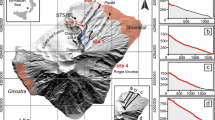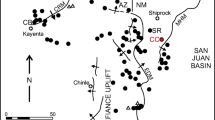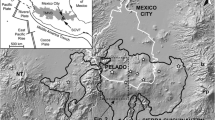Abstract
On 30 March 1956 a catastrophic directed blast took place at Bezymianny volcano. It was caused by the failure of 0.5 km3 portion of the volcanic edifice. The blast was generated by decompression of intra-crater dome and cryptodome that had formed during the preclimactic stage of the eruption. A violent pyroclastic surge formed as a result of the blast and spread in an easterly direction effecting an area of 500 km2 on the lower flank of the volcano. The thickness of the deposits, although variable, decreases with distance from the volcano from 2.5 m to 4 cm. The volume of the deposit is calculated to be 0.2–0.4 km3. On average, the deposits are 84% juvenile material (andesite), of which 55% is dense andesite and 29% vesicular andesite. On a plot of sorting vs median diameter (Inman coefficients) the deposits occupy the area between the fall and flow fields. In the proximal zone (less than 19 km from the volcano) three layers can be distinguished in the deposits. The lower one (layer A) is distributed all over the proximal area, is very poorly sorted, enriched in fragments of dense juvenile andesite and contains an admixture of soil and uncharred plant remains. The middle layer (layer B) is distributed in patches tens to hundreds of metres across on the surface of layer A. Layer B is relatively well sorted as a result of a very low content of fine fractions, and it contains rare charred plant remains. The uppermost layer (layer C) forms still smaller patches on the surface of layer B. Layer C is characterized by intermediate sorting, is enriched in vesicular juvenile andesitic fragments, and contains a high percentage of the fine fraction and very rare plant remains which are thoroughly charred. Maximum clast size decreases from layer A to layer C. The absence of internal cross bedding is a characteristic of all three layers. In the distal zone (more than 19 km from the volcano) stratigraphy changes abruptly. Deposit here consists of one layer 26 to 4 cm in thickness, is composed of wavy laminated sand with a touch of gravel, is well sorted and contains uncharred plant remains. The Bezymianny blast deposits are not analogous with known types of pyroclastic surges, with the exception of the directed blast deposits of the Mount St.Helens eruption of 18 May 1980. The peculiarities of deposits from these two eruptions allow them to be separated into a special type: blast surge. This type of surge is formed when failure of volcanic edifice relieves the pressure from an inter-crater dome and/or cryptodome. A model is proposed to explain the peculiarities of the formation, transportation and emplacement of the Bezymianny blast surge deposits.
Similar content being viewed by others
Author information
Authors and Affiliations
Additional information
Received: 19 December 1994 / Accepted: 12 December 1995
Rights and permissions
About this article
Cite this article
Belousov, A. Deposits of the 30 March 1956 directed blast at Bezymianny volcano, Kamchatka, Russia. Bull Volcanol 57, 649–662 (1996). https://doi.org/10.1007/s004450050118
Issue Date:
DOI: https://doi.org/10.1007/s004450050118




